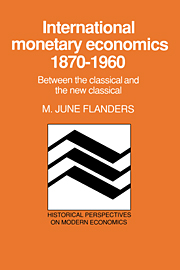Book contents
- Frontmatter
- Contents
- Preface
- 1 Preliminaries
- 2 Stream P
- 3 The beginnings of the neoclassical tradition
- 4 The locus classicus of the neoclassical position
- 5 The Macmillan Committee
- 6 A second diversion: Keynes and the Macmillan Committee
- 7 The anti-neoclassicals
- 8 Indian currency and finance: a tract on monetary reform
- 9 A treatise on money
- 10 Late Keynes: towards Bretton Woods
- 11 The crisis writers
- 3 Stream F
- 4 The confluence
- Ex post
- Bibliography
- Index
6 - A second diversion: Keynes and the Macmillan Committee
Published online by Cambridge University Press: 12 October 2009
- Frontmatter
- Contents
- Preface
- 1 Preliminaries
- 2 Stream P
- 3 The beginnings of the neoclassical tradition
- 4 The locus classicus of the neoclassical position
- 5 The Macmillan Committee
- 6 A second diversion: Keynes and the Macmillan Committee
- 7 The anti-neoclassicals
- 8 Indian currency and finance: a tract on monetary reform
- 9 A treatise on money
- 10 Late Keynes: towards Bretton Woods
- 11 The crisis writers
- 3 Stream F
- 4 The confluence
- Ex post
- Bibliography
- Index
Summary
Keynes the neoclassical
As I noted above, the Keynesian influence in the Macmillan Report is clear when one examines the report. In fact, Keynes was not only a member of the committee, and not only played a large role in writing the report, he was also a major witness before it. His very extensive testimony there (lasting many hours through a number of sessions) is readily available now and it makes fascinating reading (Keynes 1929–31 [1981: 38–312]). Throughout the testimony, Keynes frequently reminds his interlocutors that they will shortly be able to read a “technical” version of his ideas, since his Treatise on money is about to be published, and did in fact appear during the prolonged course of the committee's hearings.
On the first occasion on which he testified (February 20, 1930), Keynes presented his view of the historic role of Bank rate policy. “Bank rate” here includes all the means at the disposal of the Bank of England to influence the terms of lending.
The great historic virtue of Bank rate policy is … that it works on both … [the current and capital accounts] and on both in the right direction … But the way it works on the two factors is very materially different. Its influence on lending is rapid, but not permanent … The Bank rate could not restore permanent equilibrium, if it merely affected the short-loan situation. On the other hand, its immediate efficacy on the short position is very great. Its influence on the price factor is is very materially different. […]
- Type
- Chapter
- Information
- International Monetary Economics, 1870–1960Between the Classical and the New Classical, pp. 107 - 120Publisher: Cambridge University PressPrint publication year: 1990



